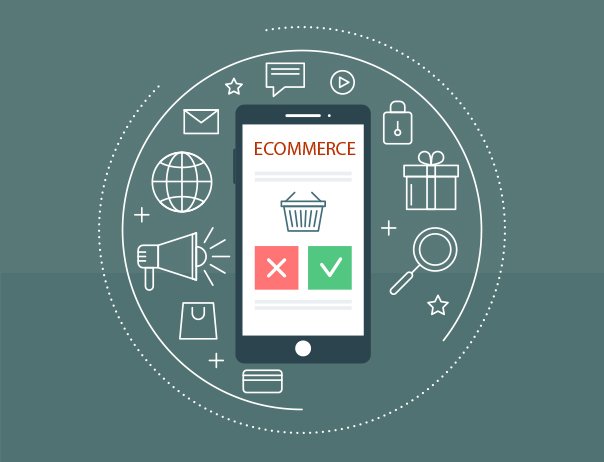
It’s 2018 and the eCommerce market has changed the way business is conducted, whether in retail or business-to-business, locally or globally. Prior to the Internet, success in retail was said to hinge on just location. Now, however, the Internet is a global marketplace; even the smallest retailer can afford a national – if not a global – presence. Inaccessible locations now have websites, and new companies now sell products that were unthinkable prior to the internet and recent technological developments. The scope of the eCommerce marketplace is difficult to measure; the eCommerce market has become such a vital part of the economy that it is difficult to pinpoint exactly where eCommerce begins and the old world economy ends.
Globally, eCommerce sales account for almost 10% of products sold. That might seem like a small percentage, but this percentage amounted to a whopping 2.3 trillion dollars! This is just the beginning; according to Statista, the value of global Commerce sales for 2018 is projected around 2.8 trillion, and over 4.8 trillion in a mere three years. Clearly, there is a pattern to be observed, one that predicts an exponential rise in online sales over the coming few years.
eCommerce Trends of 2018:
 The eCommerce market share in 2018, as a percentage of all retail sales, is expected to increase to 11.9% – up from 3.5% a decade ago! To capitalize on this trend, in particular, companies must also focus on optimizing their in-store experiences in collaboration with their eCommerce expressions to give their customer a standardised- and smooth- shopping experience. Content is everything; it is educational, helpful, and entertaining. As a marketing strategy, it’s also cost-effective and impactful to ROI; 78% of CMOs see custom content as the future of marketing. Not to mention, brands that rely on content save over $14 on each new customer acquired!
The eCommerce market share in 2018, as a percentage of all retail sales, is expected to increase to 11.9% – up from 3.5% a decade ago! To capitalize on this trend, in particular, companies must also focus on optimizing their in-store experiences in collaboration with their eCommerce expressions to give their customer a standardised- and smooth- shopping experience. Content is everything; it is educational, helpful, and entertaining. As a marketing strategy, it’s also cost-effective and impactful to ROI; 78% of CMOs see custom content as the future of marketing. Not to mention, brands that rely on content save over $14 on each new customer acquired!
In the last 3 years, you’ve probably seen your mobile traffic outpace or at least come close to your desktop traffic. What’s interesting, however: people browse on mobile, but they still buy on desktop. Despite the rising prevalence of mobile, retailers are still trying to figure it all out. For one, consumers aren’t just browsing content on mobile: they’re making purchases. In the U.K., for instance, mobile spending tripled in the first half of 2017. Rather than tracking these variations in behavior, eCommerce stores should focus on making their on-site experiences as easy to use as possible.
The Good Ol’ Website:

In the age of the mobile, you might be wondering “what can a website do for me?”, well, it can do a lot actually! By giving your customers information to building a relationship with your eCommerce business, a good website can help you scale to new heights. However, a website still doesn’t replace an app, and an app doesn’t replace a website. They both offer unique advantages to eCommerce businesses, and they can work together! It can be more useful to consider how a website and an app can work together, not whether you should choose one over the other. Let’s have a look at some of the ways a website can benefit you:
Benefits Of A Website:
- Increase customer’s trust: A beautifully designed and creatively developed website generates trust for your customers. If the experience is smooth and efficient, not only will you have gained a customer, but also retained one. Think of it as a preview to the relationship that you establish with them; if they have a good first experience, chances are that they will come back because they know how you treat a customer. But how will these customers- who are not familiar with your brand- know about your business and trust you? Having testimonials- written and videos- a good ‘About Us’ page, regular blog posting and updated social media pages will build trust as well as brand awareness.
- Attract new clients: App stores are constantly improving search functionality to make new apps easier to discover, but app stores aren’t as accessible as the web. Websites can give smaller eCommerce companies a better chance to be seen than a mobile app; creating a website is often cheaper and takes less time than creating an app, making it a more economical option. Until Google gives apps preferential treatment in SERPs (Search Engine Results Page), the best way to attract and retain customers who use browsers is through websites. This means that websites have a powerful SEO advantage over apps because they are easier to find in search engine results they offer more traffic.
- Consumer analytics: eCommerce businesses can effortlessly keep an eye on buyers buying habits and preferences with the help of websites as they collect a host of data that can later be used to grow their business. By understanding what the customers want, when they buy and what the demand is, eCommerce businesses can ensure that they supply to the demand and grow in the right direction. By satisfying their requirements continuously, you can increase your continuing relationship with them and build long-term relations.
- Sell Products globally: By expanding to include an eCommerce aspect, you can not only sell all around the country but around the world as well! Having an online store that changes currency automatically means that your business can receive orders from almost anywhere in the world. This not only helps increase your sales but also ensures that you establish a global presence.
Rise Of The Mobile:

While a website is necessary, a mobile app gives you an edge over the competition. Creating a mobile app for your business can improve your marketing reach, and provide a unique channel for attracting new customers or engaging with existing customers. As a result of growing smartphone usage and active eCommerce activities, the projected value of the mobile retail market in 2017 was estimated at $151 billion worldwide! This goes to show that many online shoppers appreciate the advantages of mobile apps. How can an app help you take your eCommerce business to the next level?
Benefits Of An App:
- Preference for apps: The advantages of mobile apps vis-à-vis websites or even mobile responsive websites have been argued on multiple occasions. There’s no doubt in the superiority of apps over browsers: 78% of users surveyed claimed they would rather use a mobile app than access a store via a mobile browser. This preference toward mobile apps is not surprising. eCommerce applications are much more convenient to use while shopping, especially if you’re not making a one-off visit to an online store. For starters, there’s no need to remember a URL and login password to access the app.
- Mobile apps boost eCommerce sales: People who decide to download your mobile app initially show a higher level of investment in your brand. They come ready to buy, while website visitors mostly access your website to check details or look up contact information. In addition, customers spend three to four times more hours on apps than on mobile sites and access them with the intention to buy. According to research by Criteo, mobile app users are twice as likely to return to your store within 30 days compared to shoppers who access your website in a mobile browser. Let’s look at some of the ways an app can help you boost eCommerce sales:
-
- Personalization: Use information your customers provide in the app to your advantage. You can let your users customize their experience in your store, for example through prioritized features and relevant suggestions based on previous purchases.
- Push notifications: Push notifications can be used to communicate with your customers; notify them about sales and special offers or let them know when items they want come back in stock.
- Exclusive content: Implement offers that are available only through your mobile application – for example, limited deals or special prices for app users.
- Rewards system: You can encourage your customers to keep coming back by implementing a loyalty program.
- Advanced support: Good customer support goes a long way; establish solid communication 24/7 between your store and your customers. Customers should be able to solve their problems in the app via live chat or chatbot instead of having to switch to the desktop version.
- Reduced response time: The time required for a mobile app to complete an action is significantly lesser than for a website because applications store their data partially on a mobile device. Although apps connect to servers just like websites do, there’s ten times less data transmitted between a server and a mobile application than between a server and a browser. Consequently, apps retrieve data much faster.
- Increased conversion rates: The combination of satisfying UX, simple navigation and usability lead to high conversion rates. As discovered in research by Criteo, mobile apps increase the percentage of users who complete a desired action compared to desktop and mobile websites. As a result, eCommerce app conversion rates are three times higher than for mobile websites and one-and-a-half times higher than for desktop sites.
Bottomline:
As mobile apps become easier to create and maintain, many businesses are combining a mobile-friendly website with a mobile app development. This combination can give you the best chance to expand your reach to new customers, as well as delivering a unique experience and customized content, deals, and information to your most loyal customers. In case you’re thinking of creating an app to further the growth of your eCommerce business, provide a CTA on the website to prompt visitors to download the app. This gives you an excellent channel for reaching out to people and contacting them immediately via push notifications, as well as taking advantage of the capabilities of a mobile app. You don’t have to choose between an app and a website: your website and an app can (and should!) work together.

 The eCommerce market share in 2018, as a percentage of all retail sales, is expected to increase to 11.9% – up from 3.5% a decade ago! To capitalize on this trend, in particular, companies must also focus on optimizing their in-store experiences in collaboration with their eCommerce expressions to give their customer a standardised- and smooth- shopping experience. Content is everything; it is educational, helpful, and entertaining. As a marketing strategy, it’s also cost-effective and impactful to ROI; 78% of CMOs see custom content as the future of marketing. Not to mention, brands that rely on content save over $14 on each new customer acquired!
The eCommerce market share in 2018, as a percentage of all retail sales, is expected to increase to 11.9% – up from 3.5% a decade ago! To capitalize on this trend, in particular, companies must also focus on optimizing their in-store experiences in collaboration with their eCommerce expressions to give their customer a standardised- and smooth- shopping experience. Content is everything; it is educational, helpful, and entertaining. As a marketing strategy, it’s also cost-effective and impactful to ROI; 78% of CMOs see custom content as the future of marketing. Not to mention, brands that rely on content save over $14 on each new customer acquired! 

